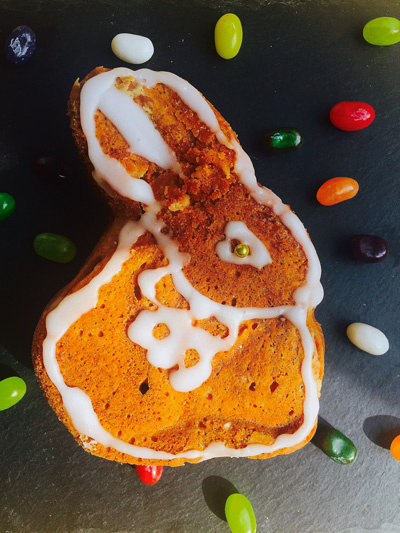SWEET EASTER with LUCUMA

Baking is simply part of the Easter season. Sweets can also be baked with a sugar alternative, for example with Lucuma powder.
INGREDIENTS:
2/3 cup white flour
½ tsp. baking soda, if desired
a small pinch of salt
2/3 cup butter or vegetable margarine
1/4 cup sugar
1 - 2 eggs or vegan egg alternative
1 - 2 tsp. Lucuma Powder
10 tbsp. Powdered sugar
1 - 2 tbsp. Water
1 tbsp. Lemon juice
Time required:
50 minutes
Portions:
Dough is enough for 2 smaller baking dishes
PREPARATION:
Basically, this is a classic sponge recipe or the 1 cup concept. Flour, butter, sugar and eggs have the same weight. Only - this time with Lucuma you need much less sugar and still have the same, delicious and sweet effect.
1. Beat butter and sugar with an electric mixer and beat the mixture until it’s combined and has a fluffx texture. This can take 3 to 5 minutes.
2. Add the eggs or egg alternative and 1-2 tsp Lucma
3. Mix flour with a pinch of salt and baking powder, sift and gently stir into the butter-sugar-egg mixture.
4. Grease baking cups like bunny, Easter egg or butterfly, dust with a little flour. Pour the dough mixture into the molds, let it rest for 20-30 minutes.
5. Preheat oven to 180°C degrees, and bake the baking cups at about 30 - 40 minutes.
6. Then take them out, let cool a little, remove the cake pieces and let them cool completely.
You can decorate either with ready-made sugar writing, here there are many different colors.
It is very easy with powdered sugar, mixed with water and a little lemon juice for flavor. Stir the liquid into the powdered sugar until a spreadable mass is formed.
Add a little more powdered sugar or water as needed.
Then you can start decorating, either with a spoon or - with a spray needle from the pharmacy it is also quite practical.
Nutrients:
BAKING POWDER is a leavening agent to increase the volume of a dough. This occurs through a chemical reaction: the action of water, acid (often tartaric acid) and heat releases gaseous carbon dioxide (CO2), which eventually leads to the enlargement. In order to bind moisture so that premature CO2 development, corn, rice or wheat flour is usually added as a separating agent.
BUTTER consists of milk fat and up to 16 percent water. It contains 2/3 saturated fatty acids, with a lower proportion of unsaturated fatty acids and a lower proportion of polyunsaturated fatty acids.
The cholesterol content is also higher than in meat or cheese, for example, with 240 mg of cholesterol per 100 g of butter. If you have to pay attention to this, you should rather reach for vegetable fats.
After all, you can find vitamins A and D.
Butter is an absolutely natural product and has an unmistakable taste, which is why it is often used in baking. However, you can easily reach for other fats.
In the EGG YOLK most of the nutrients of an egg are found such as the vitamins of the B group, D and K, as well as minerals such as calcium and potassium, magnesium and phosphorus and trace elements such as iron and iodine, copper and zinc.
The egg also contains lecithin, which not only protects the liver and large intestine mucosa, but is also important for memory and concentration. It strengthens the nerves and thus helps with stress.
On the other hand, eating egg yolk regularly is said to be harmful to blood vessels. A study published in 2012 by Canadian researchers found that egg yolk, like smoking, can accelerate the process of artherosclerosis.
Those who want or need to avoid eggs for health or ethical reasons can choose from a host of alternatives. Whether egg substitute powder from the health food store, silken tofu or chia seeds, there are a number of products that are a good choice to replace an egg yolk.
LUCUMA is a tasty and at the same time healthy alternative to sugar - and it is also low in calories, with a low glycaemic index. Good for diabetics, as the blood sugar level only rises slowly after the consumption of Lucuma.
The fruit is rich in protein, fibre, calcium and iron, potassium, magnesium, phosphorus and zinc, beta-carotene, vitamin B1, B2, B3 and vitamin C.
It acts as a good source of energy, revitalizes and inhibits inflammation and digestion.
MARGARINE is an emulsion of mainly vegetable oils, fats and drinking water. It is usually colored for this purpose and vitamins such as A and D are added.
Due to the production for spreadability (vegetable fats are hardened), trans fats are contained in margarine, which are not exactly optimal from a health point of view. This should be kept in mind.
SALT, the so-called table salt, consists mainly of sodium chloride.
To make it trickle better, calcium carbonate, magnesium carbonate, aluminum oxide, silicates or potassium hexacyanidoferrate(II) are added.
Likewise, either iodine for goiter prophylaxis or fluorine for caries prophylaxis are added for health reasons.
Salt is important for many functions in the body such as sodium for osmotic pressure or in nutrient absorption. Sodium is also involved in bone formation, the transmission of stimuli and muscle relaxation.
However, too much salt can also be harmful; people with high blood pressure or kidney problems in particular need to watch their salt consumption.
It is recommended to consume between 5 and 6 g of salt daily, i.e. about 1 teaspoon.
WHITE FLOUR comes from the innermost and lightest part of a cereal grain, called the endosperm. This consists mainly of starch and 10 percent of protein, called gluten. Thanks to this, white flour is well suited for baking fine pastries and cakes.
Incidentally, the type designation indicates how many minerals are still contained in the milled flour. For example, white flour type 405 has only 405 g of minerals per 100 g of flour. Flour used for baking bread usually has 1050 g, i.e. type 1050.
If you want more nutrients in your baked goods, you can use spelt flour. Here the proportion of vital substances such as vitamins B1, B2, B3, B5, B6, B7, B9 and E, as well as minerals such as calcium, iron, potassium, magnesium and phosphorus is higher.
In spelt flour are also found the trace elements copper, manganese, silicon and zinc.
In addition, spelt flour contains all eight essential amino acids, which is important for protein synthesis. And - spelt is low in gluten.
Enjoy!


Comments
Be the first to comment...